A BLANK SHEET OF PAPER
When the K100 was first introduced it was quite a sensation in that it wasn't a Kawasaki Z-1 nor a Honda Goldwing...It was as if someone had taken a BMW 2002tii, laid the engine on its side and chopped off two wheels. We got one of the first ones in the country and immediately set about dissecting it and figuring out how to turbocharge it. Of course we had to ride the thing first and it was as solid as a bank vault and about as exciting as watching grass grow. It needed extra power in a big, big, way. Later on, the 4 valve K1 and K1000 models improved the situation a bit, but there wasn't any quantum leap in performance. It wasn't until the K1100 came along that things started getting more sophisticated. However, the competition had progressed even further and the K series was still way short in the horsepower department.
When we started on the K Series bikes we had a blank sheet of paper facing us and decided to set a new standard and do things right. The first thing we decided to do was incorporate a 250 hp air to air intercooler. Every 11 deg F rise in inlet temperature causes about a 1% power loss. Our distributor didn't see the need for the expense. Check out our Intercooler Calculator to see what happens when you compress air. The second thing we decided to do was put a small highly advanced 180hp IHI Turbo essentially under the bike where the heat would not intefere with the rider's comfort, nor would it boil the gas in the gas tank. The third thing on our list was design a positive oil scavenge system to make sure the turbo would "drain" under all conditions. No one had ever done an intercooled, fuel injected, motorcycle before and there never had been a turbo that was sophisticated enough to be used on a daily basis. Up until this time turbos were crude draw though carbureted units that cooked your leg, fouled spark plugs, took forever to warm up, ate pistons, blew head gaskets, and only went fast in a staight line in a semi-controllable fashion.
BMW built a tough bike. The first K100's we built had a one-piece intercooler placed in front of the radiator. After about 20 kits were made we found out from a customer in Texas that in the Summer heat the bike would run hot so we split the intercooler core allowing air a direct path to the radiator...bye bye overheating. All of the K1000 / K1 / K1100 kits produced had split intercoolers. The initial kits for the K1 / K1000 / K1100's were designed to run 8 psi of boost with the stock injectors which were rated at about 14.5 lbs/hr at 36 psi. At 8 psi on the 4 valve the bike required no modifications at all and was fast enough to embarass a lot of bikes. The stock injectors on the K1000 series would cover the stock 95 real rear wheel horsepower just fine and the RSR AIC400 covered the aditional 45 hp just fine, thank you. Not many bikes had 135 rear wheel horsepower. Check out our fuel injector calculators. K1000 and up series were more sophisticated with the K1100RS making the transition to a true closed loop Motronic fuel injection system. We allowed the K1100 closed loop models to stay in closed loop mode up to 4 psi of boost.
IDIOT'S BALL
Imperfect knowledge gives less than satisfactory results. We designed the kits for 8 psi and total reliability. The injectors would not support more than 100 hp and the fuel pressure regulator was not referenced to manifold pressure so it did not "track" boost pressure. Our distributor brought us a rising rate fuel pressure regulator from Ak Miller/Cartech with the idea of running higher boost and asked us to copy it...we declined as it was a stupid idea in the first place and secondly it would be doubly stupid to waste our time making stupid things, money or nor money. Our distributor persisted with these regulators, finding someone to make poor copies of the Cartech unit. These units have about eight square inches of diaphram area which means they exponentially increase the fuel pressure as the boost pressure rises. As the pressure increases there is no hope it will exactly track your motor's needs. On it's plotted curve it will only be "correct" at one intersect. Above and below this point it cannot be "correct". Our distributor resorted to aquarium valves to "bleed off" boost pressure going to the diaphram in an attempt to adjust tings that were already out of control. Use of this set up for higher boost levels resulted in damaged motors during some speed attempts. The turbo was capable of 180hp and the injectors were only good for 100 hp and no amount of trickery was going to overcome these facts.
Enough was enough, so we instituted our "5th Injector" program calibrating it for the IHI's airflow at 8 psi which was 125 rear wheel horsepower. We tied the extra injector into the inlet plenum with a specially machined billet enclosure that was designed to enhance the spray pattern under boost. This worked spectacularly well but once again the idiots tried to ruin a good thing by trying to run "bigger" injectors and even more boost. We tried to explain this would not work as it would dump too much fuel at the lower boost levels, but the idiots were off and running again with a new toy.
Revised Fuel Control

To control the fuel properly we designed a microprocessor based manifold pressure system to supplement the oem Bosch fuel injection. This was the first RSR AIC400 unit and could be used to control one to four injectors. With the RSR AIC400 we could program one large injector or up to four new injectors in a new plenum chamber (a total of 8 injectors). This led to the marketing of "Eight Injector Kits". It also led to more dumb moves as our distributor attempted to "copy" our injector controller by conning some ex- MSD employee (he was fired) into building "microfuelers". Of course they did not tell us about this until they started having a 100% failure rate with the "microfuelers". Virtually all of the 4 Valve K series motors we did had the more sophisticated eight injector setup.
For 2003 we did a complete rewrite of our RSR AIC400 fuel control predictive software to better match the new higher output turbos we are using on the K series bikes.
As a final point in this madness we finally put one of our RSR 800i Fuel Injection Systems on a K100 race bike and went 206mph at El Mirage. Since we weren't paid for it we took it back and that was the end of that bike's career. That bike had a bigger 312hp turbo and a much larger nose mounted intercooler, forged pistons, race gas, an MSD ignition and longer rods. It also had a very special stainless steel turbo 4 into 1 header that took us five very difficult days to build...all for the cause as they say. Then there was the K1100RS we installed our RSR EFI system on that ran 196mph with only eight pounds of boost at El Mirage...The bike belonged to BMW of North America but our distributor sold it to someone else who never got the bike. It's a very long story. BMW took the bike back unassembled and we never got paid for the parts. We could tell you a dozen dumb ass stories about this, but this is why we are putting out this information...So we don't have to do it time and time again on the telephone or in person when you stop by to visit.
THAT WAS THEN, THIS IS NOW!
K1 / K1000 / K1100 kits are in limited production once again. The base units come with an RSR AIC400 2 Bar Additional Injector Controller and a new inlet plenum with one additional injector for boost up to 15 psi. A second kit incorporates a new plenum with four additional injectors and an RSR AIC400 3 Bar Additional Injector Controller for power levels above 15psi. A third kit with a full race 300hp turbo and four larger injectors controlled by the RSR AIC400 3 Bar Additional Injector Controller.
Costs for the kits are in the $3,995.00 to $4,995.00 range depending on options.
K1000/K1100 Parts in Production
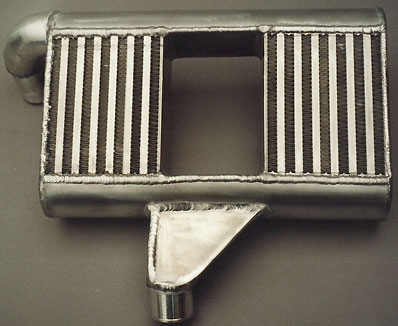
All kits are intercooled and come with everything needed for installation. The kits feature our new BoostMaster wastegates and full instrumentation. The kits feature our 4-1 stainless turbo header.
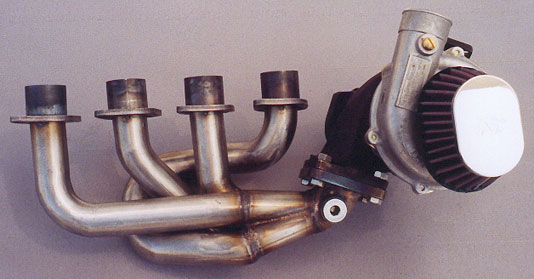
Pictured above and below is our K1000 and K1100 stainless steel turbo header. Very few people have ever seen these as they are usually hidden from sight beneath fairings and since they run forever without any problems no one actually appreciates the work that goes into them. The turbo pictured is standard and is capable of well over 200hp. Special high output 350hp turbos can be ordered. If you wish to spend an insane amount of money we also build a large tube version of this header (not for street use) that takes us about 5 days to fabricate...the one we used to run 206mph at El Mirage on a sub 1000cc K100 BMW.
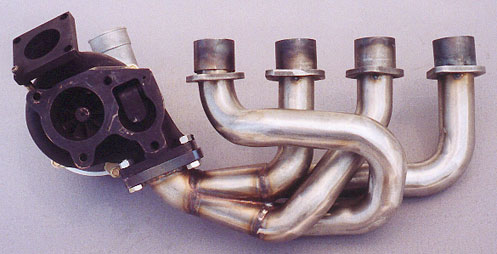
No one ever really saw one of these as they do their duty in obscurity, tucked beneath your cam cover, subject to all sorts of thermal and road-related abuse. For those of you amused by statistics and self-inflicted pain, we offer the following: 37 separate pieces of stainless steel tig welded; one used up $80.00 bi-metal saw blade; over $40.00 in destroyed abrasive belts; $40.00 of Argon in two separate cylinders vented back to our atmosphere; twelve hours of labor/wages. You figure out what it's worth. These things will whip your ass if you get lazy....Stainless is not forgiving. Those of you in the fab business know what we mean by that. Hey, you gotta do what you gotta do!
Ceramic Coated Tail Sections
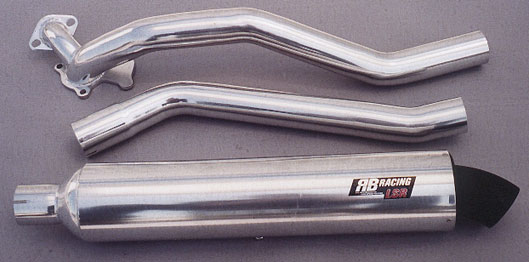
We have tail sections for the K1/K1000/K1100 that are polished silver ceramic that positively won't degrade over time. Early 1990's systems were black porcelain coated and a few were chrome plated but the new ceramic finish is superior.
All New Hardware
All oil lines are braided stainless steel and our positive oil scavenge system has been revised for 2002. Standard instrumentation is our RSR Air Fuel Ratio Gauge and a lighted glycerin filled boost gauge.The only requirement is that you send in your oilpan (see below) with it's three bolt oil filter cover in place to be modified by RB Racing for the positive oil scavenge system. This is done as the last step to prevent downtime during the installation. We had a supply of pans in stock but over the last three years we have been quietly upgrading older existing customers pans to the newer specifications, and most of these are gone.
Pans That Suck
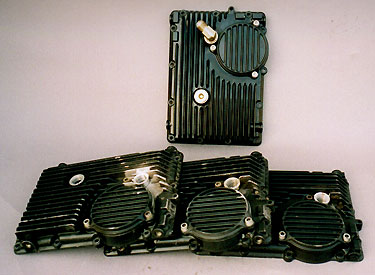
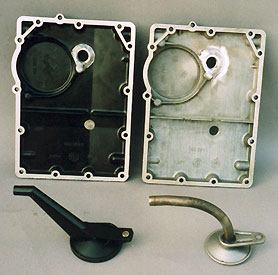
Customer pans sent to RB Racing for oil scavenge modifications featuring o-ring boss AN8 fittings for AN8 stainless steel braided lines. Positive oil scavenging "dry-sumps" your turbo, leaving no residual oil in the drain line. No matter what the circumstances i.e. shut-off, heavy braking, full boost acceleration or high G cornering loads, the turbo will drain properly. There won't be any tell-tale blue smoke foretelling of turbo bearing demise or "coking" of the oil resulting in spun exhaust shaft seals. The two pans on the right were born 17 years apart...the black one from a 2002 K1200RS and the other from a 1985 K100RS. BMW sure is getting some mileage out of that tooling. Along the way the oil pickups went from steel to plastic...the German metal workers must love extrusion machinery. When you go turbo on your K bike, you have to send us your pan with the filter cover in place. If you have the metal pickup send it also. We spent over two months in 2001 revising our oil scavenge system so we are intimately familiar with 5mm Allen wrenches and the feel of BMW oil.
The kits also feature our new small triple function priority breather / compressor discharge / and safety blow-off valve pictured in the K1200RS Turbo section.
Installation is fairly simple, requiring only the usual basic hand tools. The only modifications to your bike involve some minor trimming of bodywork so the intercooler and its connector pipe will fit.
We will be posting more details on the parts and options in the months to come and will be featuring customer bikes as they are done. Stay tuned. These are perfect mild mannered turbo bikes.
New 70.5mm Forged K1100 Turbo Pistons
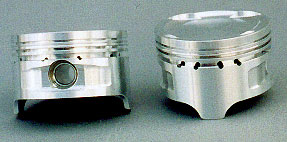

New forged pistons that we developed for the K1200 series are also available for the 70.5mm bore K1100 series motors. These pistons feature a "dished" dome that lower the compression, allowing you to run more boost without the fear of cracking the stock pressure-cast pistons. The pistons come complete with rings and pins and are a direct drop-in. Earlier K100 motors were mildly tuned. It was the K1100 series that upped the horsepower to the 95 hp range with static compression ratios of 11.0:1. These pistons are necessary for K1100 turbo kits. The photo to the right shows the 2mm pins we had to have flown in from Germany to "pin" the second ring. These pistons are lighter than their stock components. Being forged they will deform before they break off chunks that tend to scramble valves and wipe out the rings and score the Nikasil bores. We always raced with forged pistons. Once upon a time we did take a stock K1100RS and run 196mph with 8 psi and stock pistons, but that's a long story.
Yeah...But
My bike is fast enough! No it isn't..they never are and BMW's are so conservative that Japan Inc. always has something that will clean your clock. BMW doesn't change things for a decade or more while the Japanese pop out new models on what seems to be now a semi-annual basis...and they get better and better.
Turbos break parts! No, the turbo just sits there passing some oil through it's veins, waiting for you to ask it to pump more air into your motor than it could do by its lonesome. Turbos increase torque, so you shift earlier without having to wind the motor so hard. You don't have to run more than 5 psi to have a 25% increase in power and even at a lowly 8 psi there can be a 50% increase. In short, you can turn up the power for a 100% increase but there is no need to. It's nice to know the potential is there.
I'll wait till BMW Supercharges the bikes. Go ahead and wait. The clock is ticking and even if the bell rings the turbos will be superior. In case you weren't around back in the Formula One Turbo era, turbos were the weapon of choice, even for BMW. Superchargers are there full time, directly coupled to your engine's rpm whether you want the extra oomph or not...and with their fixed drive ratios, your boost is limited. With turbos you recapture wasted exhaust energy and you only use it when you need it...and unlike superchargers, you get to set whatever boost or power level you want.
I'll stick with a pipe and chip upgrade. Boy are you in for a $1000.00 surprise. You are $1,000.00 poorer, the cops can now hear you, and that Motronic computer is busily rewriting all those "not-so-clever" edits back to stoiciometry. Then there's the matter of your exhaust supplier telling you that noise equals power while he doesn't realize BMW fuel limited your equation from the get-go. Then your "chip-guy" didn't understand that BMW programs way below stoiciometry and lets the computer add fuel which takes into account hot weather and high altitude scenarios. Your chip guy tests where his ass is and not where you might go...think about it. BMW routinely looks at these "chips" and has a big laugh. Your bore and stroke are set in stone and your compression ratio is already pretty high...there isn't much you can do.
Turbos cost too much. Your BMW costs too much. In 1971 a R75/5 could be purchased in Germany for $1,300.00 US. Now you pay $15,000.00 to $20,000.00 for your BMW. Turbos are more bang for your buck than anything you can buy, and their level of sophistication and refinement make them a real bargain. These days you often spend money without results. Turbos give results.
I want to win dyno contests...I want to go 200 mph. All of this has been done dozens of times. It all depends on how much horsepower is required for the given situation. Generally if you want to push towards the upper limits, forged, lower compression pistons, water / alcohol injection, and clutch upgrades are necessary. The turbos we use are capable of 28 psi at sea level but run out of air at about 22 psi as beyond this the turbine excedes 180,000 rpm and ceases to "pump" more air. In effect, the compressor wheel appears as a "solid" to the incoming air. In fact, the turbos, at sea level, pump about all the air they were designed for at 15 psi. Running at 2500 feet altitude we never used more that 18 psi and at Bonneville with an altitude of 4500 feet, never more that 20 psi. In dyno contests at sea level, with water alcohol injection we ran up to 22 psi. You can run over 200 mph with as little as 8 psi with one of our larger (K11 / K12/ K100 Race) turbos, assuming you change your final drive ratios. It is a good idea to stick to the factory mandated rev limits in most cases as this keeps the valves from "floating" and keeps the crankshaft in it's design limits. Revving early K100 two valve motors to 12,000 rpm plus would float the valves and break camshafts if stiffer valve springs were not used. BMWs are tough motors, but planning is required for championship bouts.
More to Come
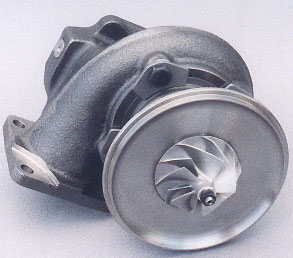
Pictured above is our new larger flow turbo for the earlier K series motors. Instead of 180hp this one will push past 225hp and is very linear in response. We do extensive machining on the housings and then ceramic coat the ni-resist iron housing. All the new turbos are being set up for the investment cast, stainless steel BoostMaster Wastegates.
We will be posting more details on the parts and options in the months to come and will be featuring customer bikes as they are done. Stay tuned. These are perfect mild mannered turbo bikes.